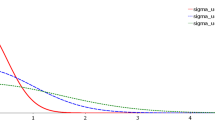Abstract
The notion of time-space prisms has often been used in the context of describing activity-travel patterns of individuals. This paper presents a methodology for estimating the temporal vertices of time-space prisms using the stochastic frontier modeling technique. Observed trip starting and ending times are used as dependent variables and socio-economic characteristics and commute characteristics serve as independent variables. The models are found to offer plausible results indicating that temporal vertices of time-space prisms, though unobservable, can be estimated based on temporal characteristics of observed activity-travel patterns. Comparisons of stochastic frontier models of prism vertices and the distributions of prism vertices are presented using two activity data sets collected in the United States – San Francisco and Miami. Differences and similarities in temporal vertex locations are highlighted in the paper.
Similar content being viewed by others
References
Aigner D, Lovell CAK & Schmidt P (1977) Formulation and estimation of stochastic frontier production function models. Journal of Econometrics 6: 21–37.
Axhausen KW & Gärling T (1992) Activity-based approaches to travel analysis: Conceptual frameworks, models, and research problems. Transport Reviews 12(4): 323–341.
Bhat CR & Koppelman FS (1999) A retrospective and prospective survey of time use research. Transportation 26(2): 119–139.
Bhat CR & Misra R (1999) Discretionary activity time allocation of individuals between in-home and out-of-home and between weekdays and weekends. Transportation 26(2): 193–209.
Damm D (1982) Parameters of activity behavior for use in travel analysis. Transportation Research 16A(2): 135–148.
Damm D (1983) Theory and empirical results: a comparison of recent activity-based research. In: Carpenter S & Jones PM (ed) Recent Advances in Travel Demand. Aldershot, England: Gower Publishing.
Ettema D (1996) Activity-Based Travel Demand Modeling. Unpublished Ph.D. dissertation, Faculteit Bouwkunde, Technische Universiteit Eindhoven, Eindhoven, The Netherlands, 297 pp.
Fujii S, Otsuka Y, Kitamura R & Monma T (1997) A micro-simulation model system of individuals' daily activity behavior that incorporates spatial, temporal and coupling constraints. Infrastructure Planning Review 14: 643–652 (in Japanese).
Gangrade S, Kasturirangan K & Pendyala RM (2000) A coast-to-coast comparison of time use and activity patterns. Transportation Research Record 1718, Journal of the Transportation Research Board, TRB, National Research Council, Washington, DC: 34–42.
Gärling T, Kwan M-P & Golledge RG (1994) Computational-process modelling of household activity scheduling. Transportation Research 28B(5): 355–364.
Hägerstrand (1970) What about people in regional science? Papers of the Regional Science Association 24: 7–21.
Jones PM, Dix MC, Clarke MI & Heggie IG (1983) Understanding Travel Behaviour. Aldershot, England: Gower Publishing.
Jones P, Koppelman FS & Orfueil JP (1990) Activity analysis: state-of-the-art and future directions. In: Jones P (ed) Developments in Dynamic and Activity-Based Approaches to Travel Analysis. Aldershot, England: Gower Publishing.
Kitamura R (1988) An evaluation of activity-based travel analysis. Transportation 15: 9–34.
Kitamura R & Fujii S (1998) Two computational process models of activity-travel behavior. In: Gärling T, Laitila T & Westin K (ed) Theoretical Foundations of Travel Choice Modelling (pp 251–279). Oxford, England: Pergamon Press.
Kitamura R, Fujii S & Pas EI (1997) Time-use data, analysis and modeling: toward the next generation of transportation planning methodologies. Transport Policy 4(4): 225–235.
Kitamura R, Kostyniuk LP & Uyeno MJ (1981) Basic properties of urban time-space paths: empirical tests. Transportation Research Record 794, TRB, National Research Council, Washington, DC: 8–19.
Kitamura R, Yamamoto T, Kishizawa K & Pendyala RM (2000) Stochastic Frontier Models of Prism Vertices. Transportation Research Record 1718, Journal of the Transportation Research Board, TRB, National Research Council, Washington, DC: 18-26
Kondo K & Kitamura R (1987) Time-space constraints and the formation of trip chains. Regional Science and Urban Economics 17: 49–65.
Kurani KS and Kitamura R (1996) Recent Developments and the Prospects for Modeling Household Activity Schedules. A report prepared for the Los Alamos National Laboratory. Available from Institute of Transportation Studies, University of California, Davis, California.
Lenthorp B (1976) Paths in Space-Time Environments. Lund Studies in Geography, Series B, No. 44, CWK Gleerup, Lund, England.
Nishii K & Kondo K (1992) Trip linkages of urban railway commuters under time-space constraints: some empirical observations. Transportation Research 26B(1): 33–44.
Pas EI (1997) Recent advances in activity-based travel demand modeling. In: Texas Transportation Institute (ed) Activity-Based Travel Forecasting Conference, Summary, Recommendations, and Compendium of Papers (pp 79–102). Travel Model Improvement Program, US Department of Transportation, Washington, DC.
Pas EI & Sundar S (1995) Intrapersonal variability in daily urban travel behavior: some additional evidence. Transportation 22: 135–150.
Pendyala RM, Kitamura R & Reddy DVGP (1998) Application of an activity-based travel demand model incorporating a rule-based algorithm. Environment and Planning B: Planning and Design 25: 753–772.
Pendyala RM, Kitamura R, Chen C & Pas EI (1997) An activity-based micro-simulation analysis of transportation control measures. Transport Policy 4(3): 183–192.
Waldman DM (1982) A stationary point for the stochastic frontier likelihood. Journal of Econometrics 18: 275–279.
Yamamoto T & Kitamura R (1999) An analysis of time allocation to in-home and out-of-home discretionary activities across working days and non-working days. Transportation 26(2): 211–230.
Author information
Authors and Affiliations
Rights and permissions
About this article
Cite this article
Pendyala, R.M., Yamamoto, T. & Kitamura, R. On the formulation of time-space prisms to model constraints on personal activity-travel engagement. Transportation 29, 73–94 (2002). https://doi.org/10.1023/A:1012905110686
Issue Date:
DOI: https://doi.org/10.1023/A:1012905110686




